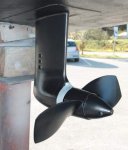ds797
Member
All other things being equal, would you have a sail drive or shaft? Most importantly, why?
Lets assume exactly the same boat, hull, rig, but there was an option for shaft or saildrive, which are you going to choose?
(For the purpose of discussion, lets assume its a 35-40ft fibreglass cruiser/racer with a fin keel and a spade rudder.
I'm guessing its going to be about 50/50 with pros and cons!
3,2,1, go!
Lets assume exactly the same boat, hull, rig, but there was an option for shaft or saildrive, which are you going to choose?
(For the purpose of discussion, lets assume its a 35-40ft fibreglass cruiser/racer with a fin keel and a spade rudder.
I'm guessing its going to be about 50/50 with pros and cons!
3,2,1, go!


